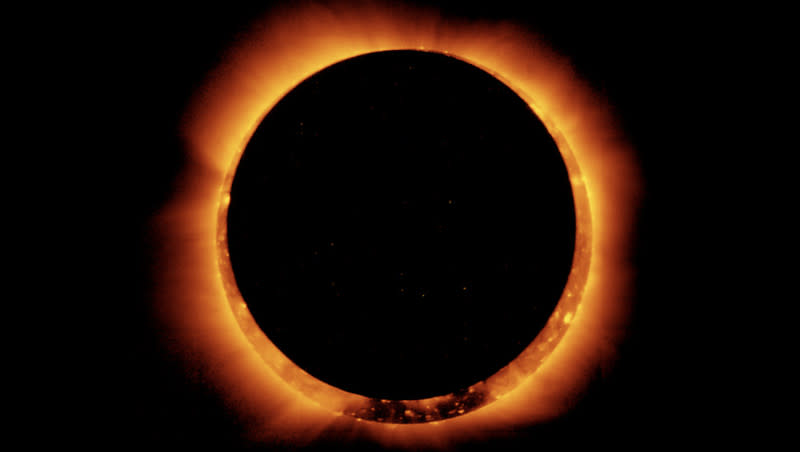What you need to know about the ‘Ring of Fire’ eclipse coming to Utah

It’s been 11 years since the last annular solar eclipse crossed the western United States, but on Oct. 14, millions will have a chance to see another one.
See the eclipse in Utah: Viewing locations include Baker, on the border of Nevada, Richfield, Panguitch, Monticello and Mexican Hat — with a population of less than 100 that is nestled up against the banks of the San Juan River. It can also be seen over Four Corners.
There are also prime recreation areas where it will be visible, including:
Bryce Canyon, Capitol Reef, Arches and Canyonlands national parks.
Natural Bridges National Monument.
Glen Canyon National Recreation Area.
Karen Garthwait, spokeswoman for Arches and Canyonlands, said the parks are expecting big crowds at a time when they are already crowded since October is an ideal, cooler time to visit.
One of Canyonlands’ two campgrounds does offer reserved spots, but all the reserved spaces at the Needles site are already taken. The parks are bringing in extra staff to help with congestion.
“If, once the eclipse happens and everyone is trying to leave at once, that will be problematic. It would be helpful if people plan and pack some extra patience that day,” she said.
Check Canyonlands website for tips on visiting during the eclipse as well as the website for Arches.
At Bryce, park staff are expecting its “first come first serve” camping spots to fill up in advance of the eclipse as well, said spokesman Peter Densmore.
“This is, of course, depending on if we have a winter-style event that could change availability.”
Anyone visiting the great outdoors to catch a glimpse of the eclipse should come prepared with plenty of food, water, gasoline and other supplies, park officials advised.
Garthwait also said eclipse enthusiasts should:
Expect heavy congestion, traffic gridlock, and long delays. RVs are not recommended.
Allow extra time to get to your destination. Bring and use eclipse viewing glasses. Never look directly at the sun without them.
Refrain from blocking traffic flow or access for emergency vehicles or face towing and ticketing. There will be no roadside parking.
Most hotels are at capacity or nearing capacity in San Juan County, according to a Facebook post the county put out Sept. 12. The post warned residents that supplies may be limited due to the anticipated influx of visitors, so preparations should be made in the next few weeks, specifically area residents should make sure to have a full tank of gas and stock up the refrigerator and cupboards.
Falyn Owens, executive director of Bryce Canyon County/Garfield County Office of Tourism, said hotel rooms are being snapped up quickly.
“I connected with a few hotels near Bryce Canyon and the gateway communities. They are reporting hotels being very close to capacity. A hotelier in Tropic said whenever they get a cancelation it fills back up within the hour.”
She said she also anticipates an increase in dispersed camping on nearby public lands.
“There are so many places in Garfield County to view the eclipse that we expect to see an influx in traffic on Scenic Byway 12 and the surrounding communities.”
Related
Americans gather in Idaho to revel in life journeys and experience a total eclipse
'My world is complete': Eclipse watchers in Idaho break camps in awe
More about the Ring of Fire eclipse: An annular solar eclipse happens when the size of the moon’s disc is slightly smaller than the apparent size of the sun. As a result, only the outer edge of the sun is visible if you are in the path of the eclipse, creating a “ring of fire” both eerie and awesome.
According to the Great American Eclipse, a website chock full of just about everything you’d want to know about the Ring of Fire eclipse, it first meets up with the United States at 9:13 a.m. Pacific time at Reedsport, Oregon.
“The shadow of the moon at this point is screaming at 7,534 miles per hour. The maximum duration of annularity at the Oregon coast is 4 minutes, 29 seconds and the eclipse will be 13 degrees high in the sky,” the site said. It hits Utah in the 9:07 to 9:09 a.m. range Mountain time when the partial eclipse begins.
After that, the annular solar eclipse begins in the 10:24 a.m. range and by about 90 minutes later, the partial eclipse is over. It ends in Texas at 12:03 Central time.
Across the United States, according to the website, a little more than 6.6 million people in the United States live in the path of the eclipse. In Utah, there are 86,000 people who live in its path, and visitation to the state could bump up by as much as 314,000.
A total solar eclipse next year on April 8 bypasses Utah and most of the West. Instead, the Great Plains region and the upper East Coast will get the treat.

